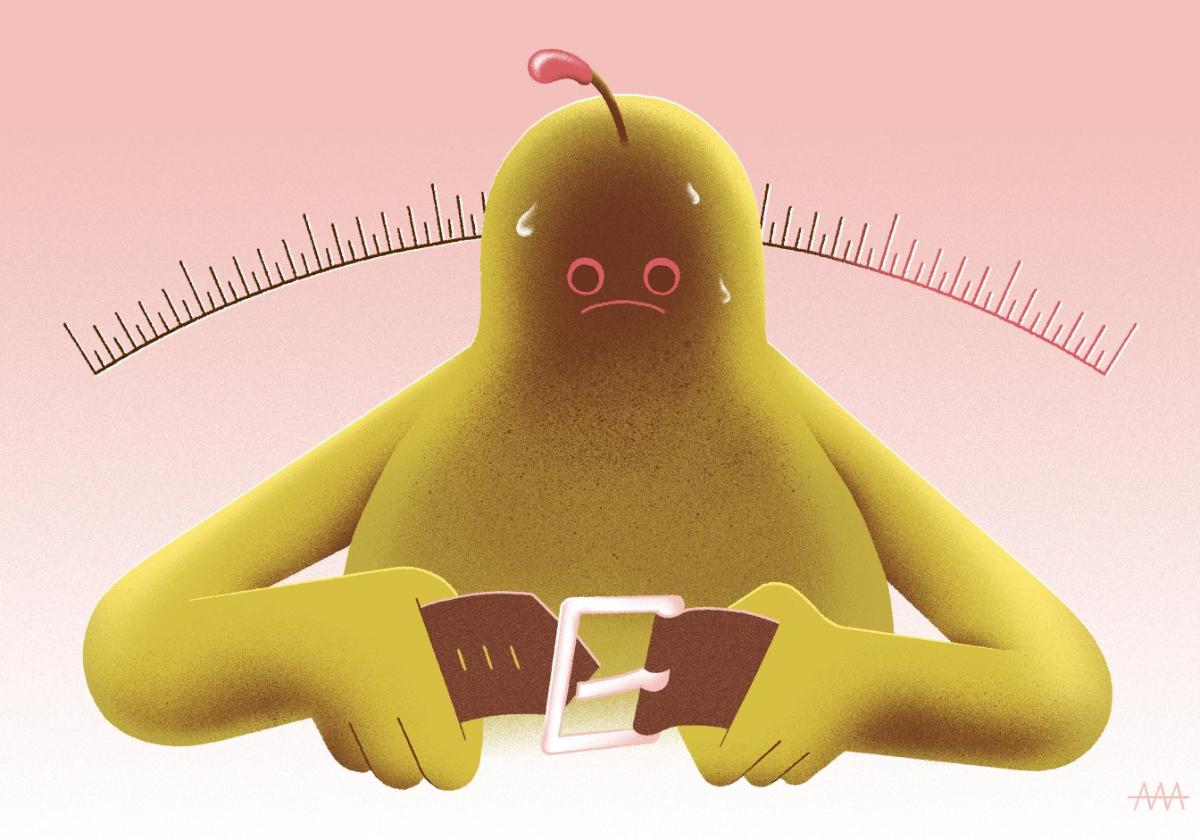

Sections
Highlight

Isabel Ibáñez
Madrid
Friday, 12 January 2024, 13:29
We often check whether our Body Mass Index (BMI) – the ratio of weight to height – falls within acceptable parameters to control our weight. However, we should also be mindful of where our excess fat is located, as depending on where it is concentrated, we may be exposed to greater health risks.
There are usually two body types in this kind of weight gain: the 'apple' shape, where accumulated fat settles in the abdomen, and the 'pear' shape, where fat is stored in the buttocks and thighs. The former is more common in men, which is why this type of obesity is called android, and the latter is more prevalent among women, hence it is called gynoid obesity. Doctors warn that an apple-shaped body, the one with a larger belly, should put us on higher alert, as it carries a greater risk of various diseases compared to the pear-shaped body, which has a narrower waist and more volume around the buttocks and hips."
This is confirmed by Giuseppe Russolillo, president of the Spanish academy of Nutrition and Dietetics: "In the case of men, android obesity is classified as a waist exceeding 102 centimetres, and in women, greater than 88 centimetres. The apple-shaped body carries many more risks because the fat is not evenly distributed but concentrated in that area." In fact, there are thin people with this issue, very skinny men with a 'beer belly' – although this type of fat belt is not caused by the consumption of beer, but by a poor diet in general. It has been proved that android obesity carries a higher risk of developing conditions such as type 2 diabetes and coronary disease, in addition to increased levels of cholesterol, insulin, glucose, and blood pressure, according to a study from Harvard University published in the Journal of the American Medical Association in 2017. This study involved more than 400,000 people and showed the increase in danger occurs in both sexes, but it is much higher when it is the woman who has an apple-shaped body.
"The good news," according to Russolillo, "is that the fat accumulated on the belly is much more moveable than the one distributed on the buttocks, hips, and thighs, which is much more difficult to eliminate because it is stored there, to serve as a reserve to meet the energy demands during lactation. The belly, on the other hand, is much easier to reduce with a combination of diet and some exercise."
And why is fat on the belly so dangerous? In addition to the fact that the fat accumulating there squeezes organs such as the liver, spleen, pancreas, kidneys and the digestive system, points out the nutritionist, "these are highly vascularised areas, and the fat we have there, when released, reaches the heart sooner, making it much easier for veins or arteries to become blocked with plaque. It's not the same to have fatty veins in the legs as it is to have them in the viscera, near the heart. Fat from the legs has time to dilute more. Mobilising fat from the extremities is not the same as doing it near the heart, next to the viscera, which it can reach more quickly."
Russolillo warns here about losing weight rapidly: "It could be dangerous because that solidified fat needs to be burned, and the adipocytes that are being released enter the bloodstream. In an apple-shaped body, they are very close to organs like the heart, and if you lose 15 kilos in a month, it's a large amount of fatty acids released into the bloodstream to be carried to the liver." Therefore, he recommends that weight loss be gradual, at a rate of about three or four kilos per month, "because the adipocytes don't just disappear; it's fat being released that needs to be burned. When you bring bacon home, you see the meat and see the fat, separate. And it doesn't go easily. It's best to follow a diet to gradually remove it from the body and consult a nutritionist to avoid releasing a large amount of fat into the bloodstream in a short time. Don't try to lose 20 kilos in a month."
Whether or not someone has a belly depends on their diet, lifestyle and individual predisposition. Although certain foods like sweets and alcohol do tend to lead to apple-shaped bodies, "because fat deposits more rapidly from sugars". Regarding exercise, caution is necessary, warns Russolillo, "and a personalised study of the exercises that can be done is essential, considering that we are talking about obese or overweight individuals." However, walking for 45 minutes a day is perfect.
Noticia Patrocinada
Publicidad
J. Gómez Peña y Gonzalo de las Heras (gráfico)
Encarni Hinojosa | Málaga, Encarni Hinojosa y Antonio M. Romero
Sara I. Belled y Jorge Marzo
Esta funcionalidad es exclusiva para registrados.
Reporta un error en esta noticia

Debido a un error no hemos podido dar de alta tu suscripción.
Por favor, ponte en contacto con Atención al Cliente.

¡Bienvenido a SURINENGLISH!

Tu suscripción con Google se ha realizado correctamente, pero ya tenías otra suscripción activa en SURINENGLISH.
Déjanos tus datos y nos pondremos en contacto contigo para analizar tu caso

¡Tu suscripción con Google se ha realizado correctamente!
La compra se ha asociado al siguiente email
Comentar es una ventaja exclusiva para registrados
¿Ya eres registrado?
Inicia sesiónNecesitas ser suscriptor para poder votar.